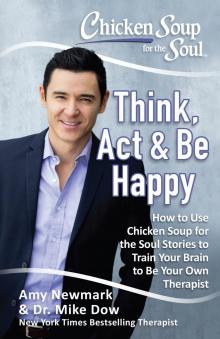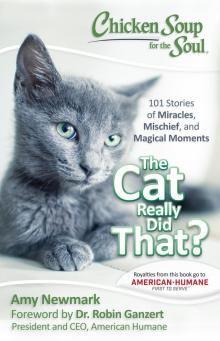- Home
- Amy Newmark
The Joy of Less Page 8
The Joy of Less Read online
Page 8
With time, my two children discovered first fad and then fashion. But me? Well that perfect lightweight skirt and shirt led to a perfect pair of jeans and then to a perfect sweater. Eventually I found myself checking the thrift shop before I purchased new clothing or kitchen cutlery or even hinges for the bathroom cabinet.
I had joined the community of and discovered the comradeship of the surprisingly large number of truly dedicated recyclers. Together, we relished the thrill of the hunt and of putting the secondhand boot to our throwaway society. We found ourselves wearing each other’s shirts and jackets and instead of hiding, we acknowledged and took pleasure from the fact that we were supporting the local hospital thrift shop and at the same time proving that new was not always nicer nor was it always necessary. For sure, less could be more in many, many different ways.
~Robyn Gerland
Increasing My Income by Getting Rid of My Junk
I am learning… that a man can live profoundly without masses of things.
~Richard E. Byrd
Each month it had become harder to cover my expenses with my retirement check. As I sat at the kitchen table with my manila folder marked “Bills” and began writing checks, I became angry with myself. I had been paying for a storage space in Detroit, Michigan for how many years? I looked at the statement start date: nearly fifteen years? Jeez! When I first moved to California, I thought I would soon be sending for all my “stuff.” Now here it was fifteen years later and I still hadn’t shipped my belongings to the West Coast.
I realized that I was hanging on to those things more for the sentimentality and not because I really needed that garage full of packed boxes and egg crates stuffed with record albums. It was time to get rid of it. I looked at the bill for my storage space and a chill ran down my spine. Over the years, it had quadrupled. When I leased that spot, I had no idea they had the right to increase my storage fees annually. What had started out as a reasonable rental amount was now costing me a third of what I was currently paying for my apartment. Ridiculous! It just so happened I had booked a flight to Detroit to attend an annual weekend jazz festival. So, I decided to use that trip to get rid of those things in storage.
A few weeks later, I stood staring into a garage sized storage space piled high to the ceiling with junk. My nephew and his teenaged son stood by my side.
“Wow, Aunt Dee,” they both muttered, overwhelmed by the magnitude of things stuffed into that storage space.
We started going through the boxes of knick-knacks, bathroom towels, bedroom sheets and comforters, kitchen curtains, pots and pans. I’m an avid reader and there were boxes of books galore; magazines that went all the way back to the 1950s; clothes I would never fit into again. We made piles to give away to a church that housed the homeless and protected battered women. Each evening, I drove to that church with a carload of clothing and household goods. They itemized the donations and I received receipts that I could use as tax write-offs. The eradication had begun, happily with some of my junk going toward a good cause.
One entire wall of the storage space was stacked with record albums. A friend suggested I contact a local record shop that sold collector items. When I reached the owner by telephone, to my surprise, he rushed over to the storage facility. His eyes grew large when he saw my collection of over 3,000 record albums including The Beatles, Rolling Stones, Malcolm X speeches, Richard Pryor Live and Motown icons, not to mention an incredible jazz collection from the 1960s and 1970s. He offered me $2,500 and I took it before he changed his mind. Honestly, I didn’t know how I would ever get rid of my precious record collection and I couldn’t afford to ship it back to California. Finding that record store was an unexpected blessing.
I donated some of the more precious things, like my Paul Robeson 78 RPM collection, to a mobile museum that features African American memorabilia. It made me feel good to know that some young people would be exposed to important historical items at that museum, like the music of Paul Robeson.
It took a week and a half to go through all those boxes of stuff. I worked it like a day job, arriving at the storage facility at nine in the morning and leaving at five. I couldn’t believe how much I had collected over the years. A lot of it wound up in the garbage bin, but anything usable was donated.
My nephew ran across an old jewelry box full of broken pieces of jewelry, most of which was fake. But he showed me a few single earrings without a mate that were obviously gold and some old gold chains I had forgotten about.
“You can make money selling this gold, Auntie,” he suggested. “I know a place.”
“Okay. Let’s go see what we can get for it,” I agreed.
One gold chain was broken and three earrings were stuffed in a soft, purple, velvet bag, but there was only one of each. I suppose I’d lost their mates years ago. I doubted I would get much. The next morning, at the gold redemption place, a woman weighed my jewelry and when she told me she could give me $1,500 for the pieces, I nearly fainted. Another blessing!
I looked at the bill for my storage space and a chill ran down my spine.
I took some of that money and paid my nephew and his sons for their help over the past week. I used some of the money to ship home a few precious things, ones I couldn’t bear to give away. I discovered that for about fifteen dollars you can ship a large USPS Priority Mail box, regardless of the weight, and it will arrive at its destination in just two days. That saved me a lot versus paying the airline for baggage charges.
When I returned to California, I was ecstatic. I had stopped the storage fees, found new homes for my usable items, and had even made a few thousand dollars, after expenses, by selling the gold and the record albums.
As a senior citizen, living on a fixed income and making extra money by writing features for magazines, it can sometimes be tough making ends meet. When I look back at all those years I was paying storage fees, I think about how I could have used that money to help put some of my grandchildren through college. As I write this, I wonder: what took me so long?
~Dee Dee McNeil
Hung Up
Unless you are prepared to give up something valuable you will never be able to truly change at all, because you’ll be forever in the control of the thing you can’t give up.
~Andy Law
Almost every bit of wall space, from the basement to the upstairs bedrooms of our Cape Cod–style house, was covered with artwork and artifacts. Visitors called our home a museum. I took it as a compliment. I like museums and I enjoyed living in one.
After sixty-three years of marriage, and me long retired from my fifth-grade classroom, Arthur and I were moving to a smaller space, a sunny condo apartment nearby. Which pieces of art would we take with us? What would we dispose of? Slowly, we began the process of making decisions and taking everything down.
And then a funny thing happened along the way.
Warren, the younger of my two sons, is an artist. It seems to me that he was doodling and drawing from the time he was old enough to hold a crayon. His orange and black bullfighter painting won first prize in a competition when he was eight years old. Fifty years later, that painting was still hanging in my kitchen. Dozens of others — many of them large canvases — watercolors, acrylics, and oils, created when he was in high school, added color and warmth to a dark basement.
Now a professor of visual art, Warren has worked in a variety of mediums, including “visual literature.” His living quarters are small, and my home had become the repository of his work. Beautiful collages made with flax, Earl Grey tea leaves, Chinese spirit paper, fabric, music notation and foreign language symbols were hanging in every room of our house — along with an abundance of other objets d’art we acquired along the way.
Friends and relatives, doodlers as well as serious artists, knew where they’d find an appreciative audience — and wall space. We were the delighted recipients of their work: a mother/child photograph, pebble sculpture, wool weaving, paper cutouts and assorted paintings. When tra
veling, we searched for unusual handcrafted decorative plates. On weekends, Arthur and I sought out arts and crafts fairs. The work we bought from the mostly young artisans competed with our son’s for wall space.
I was, and still am, an antique nut, with many collections — clocks, carnival glass, irons, trivets, trays, and trunks. Whether traveling abroad or browsing at a local yard sale, I rarely came home empty-handed. Except for our trunks and glassware, we found a way to mount them all.
We managed to find space for posters, picture postcards, and glossy photographs torn from calendars and magazines. Treasured family snapshots were hung in various places, a visual orgy of nostalgia. For celebratory occasions, Warren sent original poetry and colorfully illustrated handcrafted cards. We hung those too of course — in his old room.
I was forty-four when my kid brother became ill and died — a devastating time. Not long afterwards, while passing an upscale Manhattan art gallery, I spotted a colorful impressionist painting of three young children that could have been a portrait of his two sons and daughter. I couldn’t get it out of my head. It far exceeded our budget, so I kept returning — just to visit it. “My Brother’s Children,” I called it. Eventually, I gifted myself, and squeezed it onto a busy wall.
In retirement, I registered for two adult education courses — collage and decoupage. “You’ve been doing this for a while,” the instructor commented when she glanced at my first attempt, a skyscraper collage. “I’ve been doing it in my head for years,” I whispered. Subsequently, I mounted my own series in the attic foyer. For my decoupage class, I found a sheet of wrapping paper imprinted with Bruegel’s famous “Children’s Games” painting, and patiently applied many coats of shellac. It became a “museum” favorite.
I couldn’t bring myself to dispose of anything. Most every piece on my walls had a story to tell, all meaningful to me. Our moving date was getting closer, and we needed to get on with it. “Perhaps we could put some of it on the ceilings,” I joked.
We began by taking down the smaller and incidental pieces: calendar and magazine art, photographs, posters, prints, and greeting cards. As I emptied the walls, I was overcome with an unexpected sensation. The rooms suddenly felt brighter, cleaner, sunnier, larger. The newly exposed white walls became interesting surfaces of their own, reflecting an ever-changing display of light and shadow. It seemed to me that I felt calmer. Each piece of furniture rose to a position of greater prominence. Guests inquired about our new chairs, trunks, cabinets and tables, items they’d sat on or walked past for years.
As I emptied the walls, I was overcome with an unexpected sensation. The rooms suddenly felt brighter, cleaner, sunnier, larger.
I envisioned my apartment walls — spare and sparse — a selection of major pieces, each strategically hung: a butterfly tray collection over the living room couch; decorative plates above the dining room server; a friend’s weaving capping a large old trunk; my Bruegel decoupage crowning the den sofa, an eight-year-old’s prize-winning bullfighter painting in the kitchen. And didn’t “My Brother’s Children” deserve its very own space? Not exactly spare and sparse, you say? A gallery, rather than a museum.
I didn’t trash my prized pieces, now removed from prominent display. I took each from its frame, split the pile into three slim folders, and stored them in an antique file cabinet, where I’d be able to revisit them whenever I wished. The frames were thrown into three large cartons, awaiting an upcoming yard sale.
Warren took some of his smaller paintings, and gave permission to dispose of his large teenage canvases. “They’re not very good,” he said. I left some for the new homeowner, kept a wild abstract for the apartment, sold the others at our yard sale. Newlyweds, recently relocated from across the country, “to study art” they told us, arrived at the sale toward the end of the day, looking for a chest of drawers. “Artists?” my husband exclaimed, pulling a remaining carton with dozens of frames from the garage. The young couple would have loved to buy them all, but confided they couldn’t afford it. Oh good, I thought, I could fill a wall with those things.
Instantly, I stifled the thought, and pushed the carton in their direction. “A wedding gift,” I heard myself offer. They were flabbergasted, and delighted. So was I. The wide smiles on their faces matched mine.
~Ruth Lehrer
Coffee Corner
I orchestrate my mornings to the tune of coffee.
~Terri Guillemets
I opened my eyes and stared at the green numbers on my bedside clock — 4:30 a.m. Last time I’d dared to peek, it had been 3:45. Clearly, I wasn’t going to be able to talk myself into going back to sleep. Might as well get up. At least I’d have time for some quiet meditation and maybe even a walk around the block before the demands of the day came at me full force.
But first… coffee.
I padded down the hall to the kitchen, flipped on the light and headed to the coffee corner, which occupied every inch of counter space between the sink and refrigerator. When I’d moved into this house more than twenty years ago, the only thing I’d kept in that spot was the electric percolator I’d inherited from my favorite aunt. Though it made good coffee, it had been such a hassle to clean that I’d eventually bought a drip coffeemaker to use instead. I didn’t get rid of the percolator, though. Sure, I lived alone and didn’t really need two coffee pots. But what if I had a big crowd for breakfast and needed to serve a whole lot of hot coffee all at once?
Not long after I bought the drip machine, I learned about the benefits of fresh ground coffee beans. So I bought a grinder and wedged it between my two coffee pots. Then I bought an espresso machine — which I used twice. I don’t even like espresso.
A few years later, I succumbed to advertising pressure that had me convinced I couldn’t get along without a single-serve coffee maker. Though such a machine was expensive and took up lots of room, the idea of fixing just one cup of coffee — in less than a minute and whenever I wanted it — was impossible to resist. As was the idea I could have a dozen flavors, in decaf or regular, at my fingertips if I would purchase a handy-dandy forty-eight-pod carousel to keep nearby. Which I did, of course.
Add a sugar bowl, which I never used but which I kept on the counter because it was pretty, and a matching cream pitcher I never used because I poured cream straight into my coffee from its carton in the refrigerator. And a small basket where I kept packets of three different kinds of artificial sweeteners.
Get the picture?
Above the cluttered counter was the cabinet where I stored my mugs. On the top shelf were cups and saucers that matched my dishes. The middle shelf held an assortment of plastic travel mugs in various sizes, along with a hodge-podge of lids, most of which didn’t fit any of the mugs but which I couldn’t bear to throw away.
The bottom shelf was home to my miscellaneous collection. Mugs that pictured Santa and Rudolph and a family of happy snowmen. Orange and black Halloween mugs. Mugs from seven different national parks. An Atlanta Braves mug. An Elvis-in-a-white-jumpsuit mug. And my favorite — a mug that said “Teachers do it with class.” Although it had been decades since I’d taught school, something about that mug made me smile. Maybe it was the sentiment, but just as likely it was the size, shape and handle style that made this the mug I reached for every time it was clean.
I loaded the percolator, espresso maker, single-serve machine and bean grinder into one box. Then I wrapped the sugar bowl, cream pitcher, and every mug except the one I was using and put them in the other box.
Which, much to my delight that morning, it was. One decision I wouldn’t have to make, thank goodness.
But I did need to decide which coffee maker to use. The single-cup machine didn’t seem like a good choice. At this hour, a whole pot was what I needed. I opened the cabinet to grab a filter for the percolator, but the box was empty. Scrounging around behind an almost-empty bag of hazelnut beans and an almost-empty bag of regular beans, I finally found a filter that fit the drip machine.
I unplugged the single-serve machine, plugged in the grinder and emptied both bags of beans into it. Then I unplugged the percolator and plugged in the drip machine. I debated which kind of artificial sweetener to use, chose the yellow and pulled the cream carton out of the refrigerator. By the time my first coffee was finally ready to drink, I was too out of sorts to meditate.
So I did something else instead.
I chugged my coffee and then went to the basement and found a couple of sturdy cardboard boxes. I loaded the percolator, espresso maker, single-serve machine and bean grinder into one box. Then I wrapped the sugar bowl, cream pitcher, and every mug except the one I was using and put them in the other box. I would keep the cups and saucers (twelve in all!) that matched my dishes and donate everything else to the thrift store. I’d take my leftover single-serve pods and handy-dandy carousel to the coffee bar at church. On the way home after work, I would stop at the store and buy a canister of already-ground coffee and a box of paper filters.
Which is exactly what I did.
I smile every time I walk into my kitchen these days, even if it’s four-thirty in the morning. My coffee corner holds everything I need and nothing I don’t. In a jiffy, I can set a pot to brewing, pour a steaming mug just a few minutes later and be in exactly the right frame of mind for meditating. And still have time left for a walk around the block before the demands of the day come at me full force.
~Jennie Ivey
One Bag Rule
Simplicity is about subtracting the obvious and adding the meaningful.
~John Maeda
I was the girl with the backpack stuffed full of things that I would never need but lugged around anyway. I always had an extra pack of loose-leaf paper, a box of pencils, various pencil sharpeners, and more. All of the other girls had their trendy shoulder bags or purses and carried around just one binder. They always seem relaxed and happy, never lacking anything. Yet, here I was with a bag big enough to fit a human body and still feeling like I didn’t have enough. I got stared at every day as I scuttled through the high school hallways feeling like a freak. I wanted to be one of the cool kids, but I couldn’t bear the thought of giving up that box of tissues.

 Chicken Soup for the Soul
Chicken Soup for the Soul The Joy of Less
The Joy of Less Hope & Miracles
Hope & Miracles The Cat Really Did That?: 101 Stories of Miracles, Mischief and Magical Moments
The Cat Really Did That?: 101 Stories of Miracles, Mischief and Magical Moments The Joy of Christmas
The Joy of Christmas My Very Good, Very Bad Dog
My Very Good, Very Bad Dog My Very Good, Very Bad Cat
My Very Good, Very Bad Cat